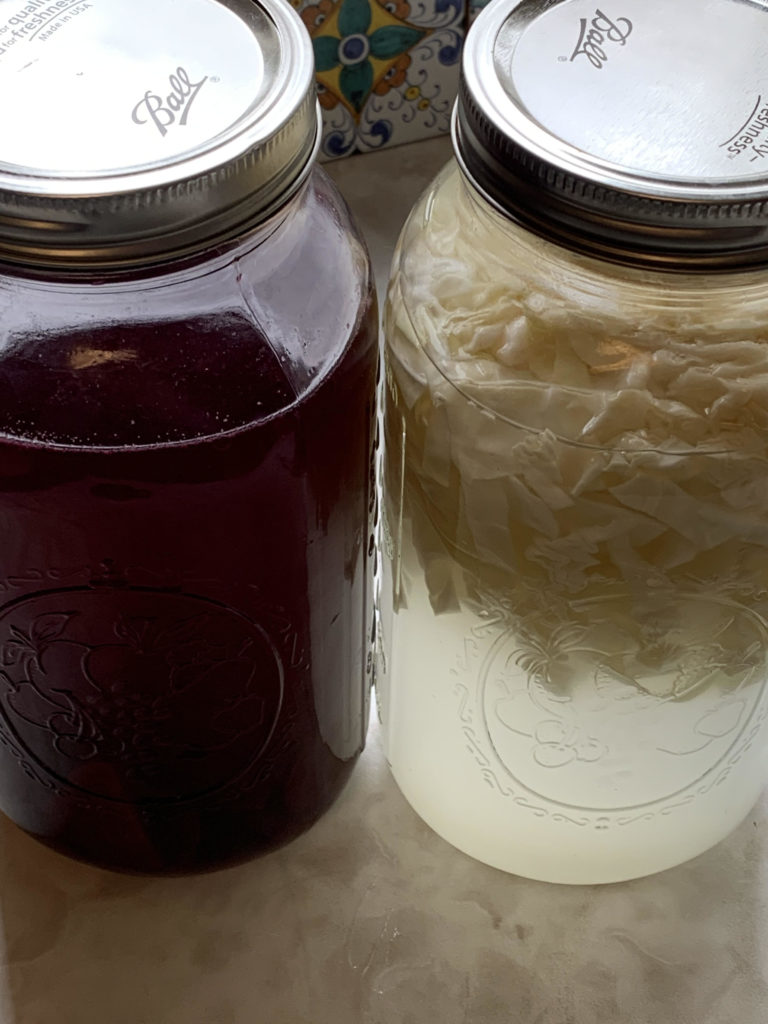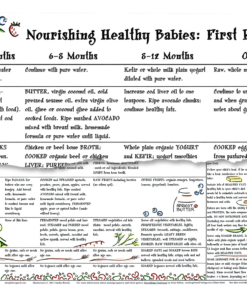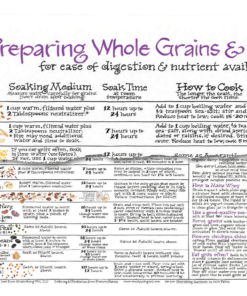It seems that the simplest things are often the most powerful. Tonics—beverages that help “tone” the body or specific systems of the body over time—are a great example. Simple and made from humble ingredients like beets and cabbage, they can be nutritional powerhouses.
Beet kvass and cabbage tonic are both used in the Gut and Psychology Syndrome (GAPS) diet, but anyone and everyone would benefit from drinking them on a daily basis. In this article I will explain why and give you some recipes. I hope you will be inspired to make them for you and your loved ones. If you have never tried lacto-fermentation, it is a great place to start!
Both beet kvass and cabbage tonic are lacto-fermented. In fact, kvass means “fermented beverage,” typically from Russia. Because these are both lacto-fermented, they are high in bioavailable vitamin C (so you can ditch that ascorbic acid you have been taking) and some B vitamins. They are also full of live enzymes and gut-soothing lactic acid, which are teeming in beneficial bacteria, or lacto-bacilli. See my book The Complete Cooking Techniques for the GAPS Diet to learn more about the myriad benefits of lacto-fermentation.
It is well known in the world of food that beets are tremendously healing. The color of beetroot, red, offers a clue to their action. Beets are known as cleansers of the blood, or blood purifiers. It is this unique quality that makes beet kvass so beneficial to the liver. While you can drink beet kvass any time of day, I suggest drinking it on an empty stomach, when you wake up and/or prior to bedtime, to best harness the unique cleansing power of the beets.
Beets have been used therapeutically in folk medicine to help resolve cases of anemia, leukemia, and even cancer. Because of their diuretic effect, beets can help with arthritis and joint issues, and they have been known to assist with regulating blood pressure. I have had clients with a history of kidney stones, and after regularly drinking two to three ounces of beet kvass daily, they reported no longer having them. Beets are also high in the amino acids betaine and glutamine. Betaine helps with liver function, detoxification, cardiovascular health, and so much more. Glutamine plays a role in the gut’s immune system function, among other things. Eating beets is obviously beneficial, so eat your beets! And ferment some, too, because the act of fermentation amplifies all of their goodness while also making them easier to digest.
Cabbage tonic has its own gift to give: the gift of stimulating digestion. It has long been known to help with digestive issues and stomach ailments. Consuming cabbage of any type—just a few bites of raw cabbage prior to a meal, raw cabbage juice, fermented cabbage (sauerkraut or kimchi), and fermented cabbage juice are all beneficial. I suggest you drink some cabbage tonic prior to meals and watch your digestion improve. It is incredibly inexpensive and easy to make. Added bonus: not many people know that the humble cabbage is very high in vitamin C. Lacto-fermenting the cabbage makes it even more so!
In order to make beet kvass and cabbage tonic, you will first need to make whey. I have included a recipe for quick whey below. However, if you prefer not to use whey as a starter, you can use a vegetable starter packet from Cultures for Health. You can also skip the whey or starter entirely, which will result in tonics that are a bit saltier in flavor.
Also, it is good to remember that beet kvass and cabbage tonics are “tonics,” not beverages. A little bit will go a long way. Two or three ounces or a bit more per day is enough.
Quick Whey
One quart of commercial yogurt yields about 2 cups of whey and 1 cup of yogurt “cheese.” Homemade yogurt yields even more whey, as it tends to be runnier. Store the whey and the cheese in glass jars in the refrigerator. Whey will last up to six months in the refrigerator. Yogurt cheese or kefir cheese will last a few weeks, if kept airtight.
Ingredients
1 quart good-quality organic plain whole milk yogurt or kefir (cow, sheep, or goat) with no fillers (grass-fed and homemade preferred)
Special equipment:
1 fine-mesh sieve (cone-shaped preferred)
Several layers of cheesecloth, or a tea towel, coffee filter, linen napkin, or a nut milk bag
2-cup liquid measure or bowl to fit strainer
Instructions
- Place strainer in liquid measure. Line with 4 layers of cheesecloth, or with a tea towel, coffee filter, or linen napkin. Alternatively, if using a nut milk bag, set it over a bowl to strain.
- Spoon yogurt or kefir into the strainer or nut milk bag. The whey will drip into the liquid measure, and the remaining yogurt or kefir cheese will remain in the strainer or bag.
- Leave on the counter to strain for 12–36 hours. (The longer it drips, the firmer the cheese.)
Beet Kvass
Due to its action as a blood cleanser and for liver support, I recommended drinking beet kvass on an empty stomach, morning and evening. If you wish, you can dilute it with water. Makes 2 quarts.
Ingredients
1 medium organic beet, sliced (do not grate)
1 tablespoon high mineral sea salt
5 cloves organic garlic, peeled (optional)
1 cup whey (recipe above)
1 teaspoon grated ginger (optional)
Pure, unchlorinated water (spring or filtered is best)
Special equipment:
2-quart wide-mouth jar with 2-piece lid (or airlock)
Instructions
- Place ingredients in the jar. Fill with water only to the “shoulder” of the jar. Screw lid on tightly.
- Leave on counter to ferment at room temperature (68–72°F) for 2–5 days, until the lid is tight ad you can no longer press it down with your fingers. Place in the refrigerator.
- Top off the beet kvass with water every time you pour out some to drink. When the beet is pale, begin again from scratch.
No whey option: Exclude whey and add an additional tablespoon of salt (2 tablespoons salt total).
Cabbage Tonic
Cabbage tonic, like all cabbage ferments, is especially good for increasing stomach acid, so it is best to drink it before a meal. Thanks to Sally Fallon and Mary Enig for their original recipe in Nourishing Traditions. This recipe has been adapted for GAPS. Makes 2 quarts.
Ingredients
¼ organic green cabbage
1 tablespoon high mineral sea salt
¼ cup whey
Pure, unchlorinated water (spring or filtered is best)
Special equipment:
2-quart wide-mouth jar with 2-piece lid (or airlock)
Instructions
- Finely shred cabbage with a stainless-steel knife. Place in a stainless-steel bowl.
- Pound briefly with a meat hammer or wooden pounder until leaves release their water and turn bright green. Alternatively, massage with clean hands for a few minutes.
- Place all ingredients in jar. Fill with water to the shoulder of jar, leaving about 2 inches of space between the tonic and the lid.
- Cover tightly and leave at room temperature (68–72°F) for 2–3 days, until the lid is tight and you can no longer press it down with your fingers. Place in the refrigerator.
No salt option: Exclude salt and add an additional ¼ cup whey.
No salt, no whey option: Replace salt and whey with a vegetable starter used as directed. For dairy-free vegetable starters, see Cultures for Health.
For more information about whey, yogurt, and kefir, and how to make them, see the Culturing Dairy section in my book The Complete Cooking Techniques for the GAPS Diet. You will also find a wealth of information and techniques for lacto-fermentation.

Main image from iStock/Deagreez. Post images from Monica Corrado.





